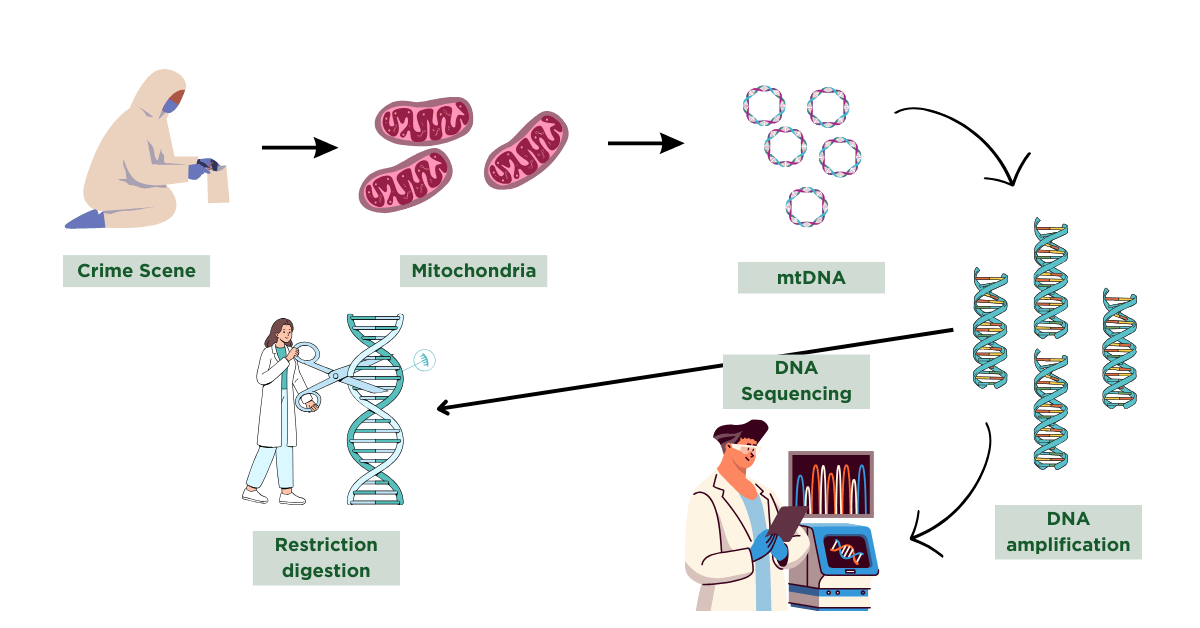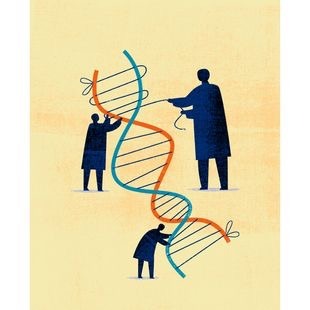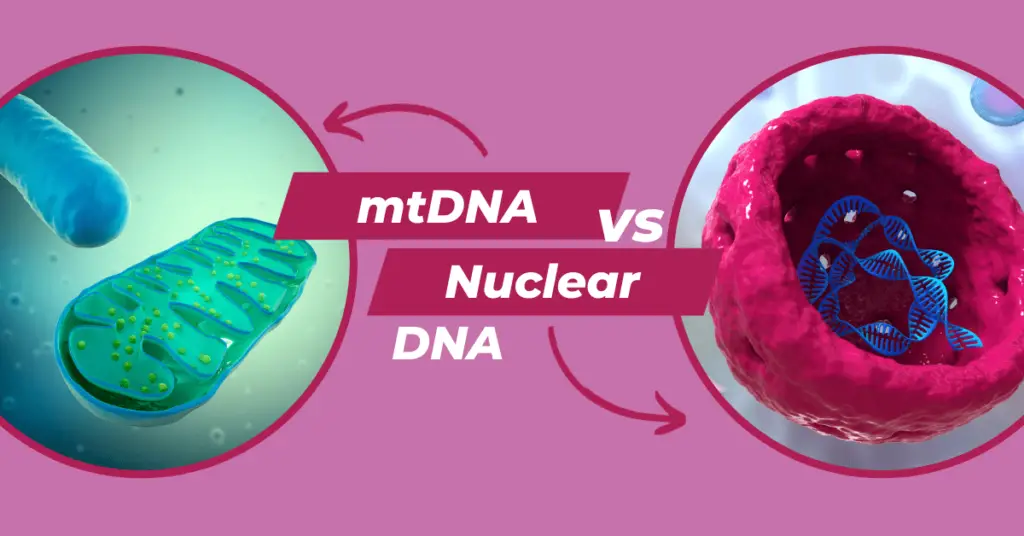“Mitochondrial DNA has been utilized for forensic DNA typing due to its various benefits and limitations over the nuclear DNA. Learn why is mtDNA typing used in forensic science.
Forensic samples like hair, blood spots, teeth or bone remains are crucial on-site crime evidence but are difficult to study and identify. Techniques like forensic DNA typing help study such samples and identify the victim or suspect.
Among all the DNA typing modules, mitochondrial DNA holds the most important place as it provides a variety of benefits over nuclear DNA and helps better understand the crime scene or a forensic sample.
mtDNA is just like nuclear DNA! A long polynucleotide chain that encodes a few important proteins. However, it has been situated in the mitochondria and not in the nucleus.
This is the reason! It’s a bit different from the ‘main’ human genome which we know as nuclear DNA. To know more about the differences between both types of DNA, you have read this article, first.
Nuclear DNA vs Mitochondrial DNA- Differences and Similarities.
This article will explain how and why mitochondrial DNA typing has been employed in forensic analysis/science. We will also look at the benefits and limitations of the mDNA as well.
Let’s start the article with an example.
Let’s consider, a brother is a victim of his maternal brother’s death. The criminal was smart and didn’t leave any physical evidence. Police found some hair follicles and blood spots from a crime scene. Now, how do they identify the culprit?
Let’s find out, but before that, let’s start with the basics.
Disclaimer: The content presented herein has been compiled from reputable, peer-reviewed sources and is presented in an easy-to-understand manner for better comprehension. A comprehensive list of sources is provided after the article for reference.
Key Topics:
Introduction to Mitochondrial DNA
Mitochondrial DNA is extranuclear and cytoplasmic DNA present in the membrane-bounded organelle- mitochondria, a powerhouse for a cell. It is a double-stranded and circular.
The circular genome consists of 37 protein-coding genes, involved majorly in oxidative phosphorylation. Having very few non-coding sequences, the mtDNA genome is located on one heavy and light DNA chain.
A cell typically contains a few hundred to thousands of mtDNA in a cell. Furthermore, mtDNA has a high mutation rate and requires nuclear genes for its metabolic activities. Thus, is strongly recommended for DNA tests and typing.
Mitochondrial DNA is an important genetic marker, like the STRs, VNTRs and Y-DNA markers for forensic investigations, parental verifications, ancient DNA studies and many other procedures.
In this article, I will explain why and how it is used in forensic science studies.
Related article: Short Tandem Repeats (STRs): A Secret of Every DNA Test
What is mtDNA Typing in Forensic Science?
DNA typing or DNA test is a biological identification technique that investigates DNA. It’s the most accurate identification method. So it is widely used in various fields including forensic science, analysis and investigations.
Unlike nuclear DNA, mtDNA (present in nucleated cells) can easily be isolated from specimens like hair, bone and teeth remains. The sample has been processed using techniques like RFLP (Restriction Fragment Length Polymorphisms) and DNA sequencing.
Mitochondrial DNA helps reveal the matrilineal identity of the sample as it is exclusively inherited from the mother’s side. Hence, it is very crucial to use mtDNA typing in forensic analysis.
Remember our example? In this case, the forensic department has the hair follicles and some blood traces. What they do is, send samples for DNA analysis which includes nuclear DNA typing, Y-DNA analysis and mtDNA typing.
How is mtDNA Typing Used in Forensic Science?
The forensic DNA analysis technique is similar to other DNA tests with other minor modifications. For this case, we require mitochondrial DNA and not nuclear DNA. So first, the lab personnel isolate the mDNA, purify, amplify, sequence, and send it for analysis.
The elaborative overview is given here, the comprehensive discussion will be given in some other article.

Sample collection
Any biological sample— hair, bone, teeth or remains, or any body fluid is collected from the crime or investigation scene. The sample is stored with adequate storage conditions and sent to the testing facility.
DNA extraction
Now, using a specialized protocol or extraction kit, the mtDNA has been isolated from the sample. The present step is so important because we have to isolate only mtDNA and not the nuclear DNA.
Expertise is required to isolate DNA from the sample. Afterward, the sample is purified, quantified and sent for the next step.
Amplification
Amplification is performed to generate copies of the target region from the mitochondrial DNA.
Digestion or sequencing
Restriction digestion and DNA amplification are two techniques used for fragment analysis. In restriction digestion, the sample is selectively digested using a specific restriction endonuclease. Sequencing reads the nucleotide sequence of the fragment.
Comparison and analysis
Now the obtained results are compared with relatives, suspects or a reference database.
Interpretation and reporting
Experts understand the results, interpret them and prepare the report.
Continuing our example. Now, the forensic expert collects the hair sample, isolates the mtDNA, sequences it and studies the results.
Why is mtDNA Typing Used in Forensic Science?
Mitochondrial DNA possesses some unique properties that make it different from nuclear DNA, therefore, it is widely used in forensic analysis and investigations.
High copy numbers
Each cell contains more than a single mitochondria and each mitochondria contains more than a single circular DNA. Meaning, that a typical cell has more copies of the mtDNA compared to the nuclear DNA.
The copy number varies from a few hundred to a few thousand. For example, an oocyte contains 1,500,000 mtDNA per cell while the spermatozoon contains 50 to 75 mtDNA copies per cell.
Higher copy numbers are advantageous because the diploid nuclear genome can be degraded over time but the mtDNA copies will remain intact. Because the more copies the more the chances we can obtain an intact DNA.
So, it assures accurate sequence analysis.
Low quality and quantity of nuclear DNA
Only two copies of the nuclear DNA are present in a cell, excluding the germ cells. In addition to that, findings suggest that it starts degrading after a few years. For example, the nuclear DNA from the bones and teeth remains obtained from the ancient samples are highly degraded.
Such a low quality and quantity of nuclear DNA is difficult to amplify and study. Hence, the intact and high copy number mtDNA is the first choice for forensic analysis.
Maternal Inheritance
mtDNA is a matrilineage marker. It follows uniparental inheritance, unlike the nuclear DNA and is inherited only from the maternal side. Therefore, the mtDNA is amazing evidence to track the maternal relationship between individuals.
I wrote an amazing article explaining 8 reasons why mtDNA is inherited maternally. You can read it to know more.

Lack of recombination
The mtDNA disallows the recombination process. Meaning, that it can’t exchange genetic material unlike the nuclear chromosomes and so can’t produce new variability. Now this is amazing and fascinating to understand.
The mtDNA, thus, will remain similar, unchanged generation after generation and helps better understand the lineage.
Lack of organization and DNA-linked proteins
Unlike nuclear DNA, mtDNA isn’t highly organized and doesn’t contain histone proteins. So in comparison to the nuclear DNA, it is easy to isolate and process the mitochondrial DNA.
Availability of reference database
These are the reasons that mtDNA can easily be studied and thus more comprehensive mtDNA databases are available online. Such databases are beneficial for accurate and sensitive forensic analysis.
Limitations
Despite its widespread acceptance in various studies, mtDNA has several crucial limitations as well.
High mutation rate and heteroplasmy
mtDNA are more prone to mutation which creates heteroplasmy meaning, different types of mtDNA in an individual. These two things can mislead results.
Maternal inheritance
Although maternal inheritance is advantageous it also limits the use of mtDNA as the paternal lineage can not be tracked.
Lack of individuality
Nuclear DNA is unique to each individual whereas the mtDNA is inherited from the maternal side and thus shared between the maternal relatives. It lacks the individuality and discrimination power to identify an individual.
Smaller genome
mtDNA has high copy numbers but due to the smaller sub-genome size, it is difficult to isolate the mtDNA effectively from a cell and from the nuclear DNA.
Prone to contamination
Mitochondrial DNA can easily be contaminated which can reduce its quality, quantity and overall discrimination power.
Lack of repetitive sequences
mtDNA has very low non-coding DNA and thus fewer repeat sequences. Markers like STRs and VNTRs in the case of nuclear DNA are present in abundance.
Now, in our example, the mitochondrial DNA collected from the hair sample and a blood spot is analyzed and compared with the sample of the dead body and the mother. This will help the authorities to find the culprit and release the innocent.
Summary:
| Advantages | Limitations |
| High copy numbers | Lack of a higher number of repetitive sequences |
| Maternal inheritance | Lack of higher number of repetitive sequences |
| Low quality and quantity of nuclear DNA | Can’t track patrilineage. |
| Degraded nuclear DNA | Lack of individuality |
| Lack of recombination | Small genome size |
| Lack of supercoiling and histones | Difficulties in extraction |
| Availability of reference database | Prone to contamination |
Wrapping up:
In conclusion, mitochondrial DNA has its own advantages and limitations to use in forensic science. However, as it remains intact for thousands of years in samples like bone and teeth, it’s a useful tool for genetic analysis.
In forensic analysis, mtDNA markers are routinely used for biological identification, crime scene investigations and solving child custody-related issues. I hope you like this article. Please share it and bookmark this page.
Sources:
Syndercombe Court D. Mitochondrial DNA in forensic use. Emerg Top Life Sci. 2021 Sep 24;5(3):415-426. doi: 10.1042/ETLS20210204.
Amorim A, Fernandes T, Taveira N. Mitochondrial DNA in human identification: a review. PeerJ. 2019 Aug 13;7:e7314. doi: 10.7717/peerj.7314.
Yao, Y., Nishimura, M., Murayama, K. et al. A simple method for sequencing the whole human mitochondrial genome directly from samples and its application to genetic testing. Sci Rep 9, 17411 (2019). https://doi.org/10.1038/s41598-019-53449-y.


